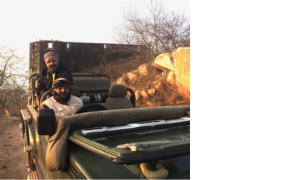
Nov 29 2024.
views 122It’s five a.m. and we set off to Jhalana forest some twenty minutes away from our base in Jaipur, Northern India. It’s January and it’s cold, our driver has every part of his body covered except for his eyes. I am wearing four tops, a coat, and a balaclava given to me by Shahnawaz, my travel buddy. It’s one size too small for my big head and cutting into my eyes. I’m counting down to sunrise and some warmth.

Our destination is the Jhalana Leopard Reserve where some thirty leopards live fenced in a 25 square kilometre perimeter. These animals are at the top of the food chain here in this well-run park and there is no shortage of deer.
The park started likely as a shooting venue for the “Britishers”, as I’m told we were called a hundred years back. However, it’s for sure that the local Maharaja of the area had a bigger impact on land use and hunting. It’s a hilly area where a lot of quarrying has taken place. On top of the biggest hill is a castle-looking property, now empty and in some bad state of decay. In my many travels across Asia, I come across so much property from the British era that has been restored. This neglected building will hopefully be restored and add a further reason to visit the park.
Always carry your country flag. It’s India Republic Day, January 26th 2023. I often travel with my own Union Jack flag. This time I wrap myself in it. The driver is not amused, Shahnawaz is used to it.
After a few hours in the park hunger kicks in and we head back to the main gate. We get three trays with assorted local food with dhal, rice and paneer and then two sorts of vegetables.

We sit above one of the many watering holes with our lunch. Rewarded with the alarm call of peacocks suddenly we realize that there could be a leopard around. We wait with our food sitting on our laps, and ducking down we behold… a leopard just walks up to the water hole to drink. What a sight!
This lush park is subject to an active replanting programme. Many trees were brought in by the Britishers and others were not indigenous to the area. Trees from Africa and some from Australia are here. Eucalyptus trees were planted in some parts of India to suck up all the available water in infested mosquito swamps. Only to find they were water guzzlers decades later.
A blue bulldeer is attacking a tree with its antlers, he is scraping his skin off with lots of blood. The driver explains the deer needs to shed its antlers and grow new stronger ones to survive.

At about six p.m. the cold is settling in our bones again and we call it a day. This forest is worth a day to anyone visiting the area. The park is well looked after with the discipline of having only fifteen official vehicles in the park with nominated drivers. The well-equipped modern jeeps are owned by the park. It makes a very pleasant day's adventure. Great to see the Indians getting it right. Lessons to be learnt for Sri Lanka game parks where there is little discipline, poor services and an abundance of dated booking procedures.
A fun day, the leopard at the watering hole, amazing terrain and time with my Indian wildlife buddy. Tomorrow it’s the amazing Jaipur Book Festival, one of the biggest in the world.
Pix courtesy Whinging Pome
0 Comments